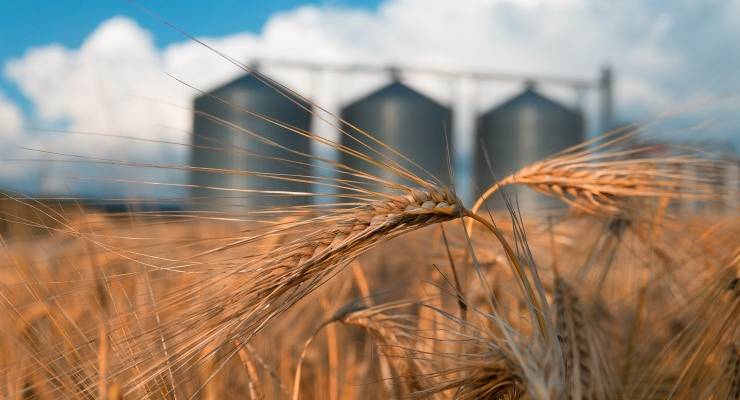
Chris Brooks — a farmer, grain speculator and former chief of Australian operations at mining company Glencore — is adamant Australia’s east coast will run out of wheat by September.
As most Australian mills are in the eastern states, this would have a severe impact: another shortage of flour, pasta, bread and other wheat-based staples in supermarkets.
In 2019, the second year of drought, an east coast shortfall was supplied in part by Canadian imports. But with the world gripped by the COVID-19 pandemic, Brooks suggests there is no guarantee foreign-sourced wheat will be available this time.
And he’s not just concerned about wheat. He fears for rice, dairy and pork too.
Brooks has been referred to in The Australian as the “most influential political activist outside of the capital cities” and has long pursued water policy reform in the Murray-Darling Basin. But his opinion on food insecurity is not widely shared.
In fact the Murray-Darling Basin Authority, the National Farmers’ Federation (NFF) and the Department of Agriculture, Water and the Environment have all condemned it.
The NFF president Fiona Simson says: “The indisputable fact is that every year Australian farmers produce far more than Australians can consume. We export 70% of the wheat we produce. According to the Global Food Security Index, Australia is ranked 10th in the world for food availability.”
In March Deputy Leader of the National Party David Littleproud wrote an op-ed telling Australians not to panic. And the April release of the NFF’s We’ve Got Your Back campaign and the Australian Bureau of Agricultural and Resource Economics and Sciences’ (ABARES) “Analysis of Australian food security and the COVID-19 pandemic” report also seemed timed to soothe anxious minds.
A government’s desire for calm amid a global crisis is understandable. But do the facts stack up?
Let’s look at the claims
The most salient point spruiked by Littleproud and the NFF — quickly adopted by the media — is the suggestion that Australia can feed 75 million people (or three times the population). This claim’s origin is murky, but it could derive from the belief that we export 70% of our agricultural produce.
That reasoning, Brooks says, doesn’t stack up because agricultural produce also includes inedible products: “wool, wine and woodchips”. The report also takes production over a three-year average, including the past two years of drought, but also 2016 which was a stellar year for agricultural production. Wheat production, for example, increased by 42.85% from 2015.
Simson counters that we still have more than enough: “75% of [Australia’s food production] is for human consumption — 25,985 kilotonnes of edible products.”
Another strident critic of NFF and government assumptions is a former RAAF deputy chief now strategic policy consultant, John Blackburn. His concern is national security and he’s analysed food supply from the perspective of national vulnerabilities.
“It sounds good to say we can feed 75 million people … ,” he says. “Are they factually incorrect about those particular figures? No. Are they distorting the picture for a political purpose? Most likely. Because they have not done the analysis.”
He says there is more to getting food to shelves than simply producing a glut of raw ingredients. Our food manufacturing and distribution networks rely on packaging materials, fuel, fertilisers, refrigerated containers and labour to ensure food reaches its destination unspoilt.
After the pandemic, distribution and the labour required for processing will return to normal. Yet much of the food on shelves arrives as the product of an extended supply chain, heavily reliant on imports vulnerable to disrupted international shipping, trade spats and measures to contain the pandemic.
Diesel, for example, is 83% imported. Recently the government doubled Australia’s emergency fuel reserves without directly acknowledging this move was linked to food supply chain resilience.
Another vulnerability is any trade difficulties with China.
‘A creeping crisis’
The last time the government looked at food security in real depth was in 2012 in the “Resilience in the Australian food supply chain” report, the result of a deep systems analysis of the food supply chains, its inputs and vulnerability. It painted a far more nuanced picture of food security than the ABARES report.
It made particular mention of Australia’s vulnerability to a “creeping crisis”, a global event that builds slowly and runs for an extended period. Something like the pandemic.
It also mentioned our vulnerability to multiple crises occurring in tandem: bushfires in one part of the country and floods in another.
Its author, Stephen Bartos, rejected Brooks’ claims about immediate wheat shortages, but expressed concern about the relationship between food security and water policy.
On this Brooks, Blackburn and Bartos all agree.
In our food bowl, the Murray-Darling Basin, water is sold to the highest bidder; priority is given to permanent crops like almonds that are very thirsty and slated for export.
This means the driest continent is essentially exporting water. This comes at the expense of staples that rely on irrigation like rice, which for this year will probably experience a shortage because Vietnam and Cambodia are limiting exports because of COVID-19.
“If we don’t have a reliable water system, then can we rely on the brave assumptions we’ve made to date? ‘Gosh we grow a lot of food so we’ll be alright.’ That’s not necessarily guaranteed,” Bartos says.
In another ABARES report, “Australian agricultural trade and the COVID-19 pandemic“, the government’s ideological colours fly at full mast: “The risks associated with creeping protectionism linked to the COVID-19 pandemic should be carefully considered and actively worked against.”
So the solution to potential vulnerabilities is simply more trade rather than problem analysis and mitigation.
Such spin in response to concerns about food security is ultimately a glib solution to a complex and escalating problem. It skirts over successive governments’ decisions to privatise our ports, commodify our water and assume the uninterrupted flow of imported inputs to our food supply chains.
All these vulnerabilities are compounded in a world entering an epoch that is less stable and therefore less predictable. As Bartos warns: “We’ve been lucky with COVID-19. We won’t always be lucky. That’s the key message.”








Once upon a time to make your way, young people followed the harvests earning good money to harvest fruit and vegetables.Is there a major impediment other than the virus to encourage young workers to the regions? over to you.
Back in the 1970s I worked picking fruit and tomatoes (the latter knocks your back about if you are not strong) and helping with the lucerne harvest (wore my denims through in a day!).
It’s hard work, especially in the humid heat of the Goulburn Valley. I still remember the sound of ripe plums falling off the trees and brushing down through the tall grass to plop onto the ground.
I can’t see why men should prefer parasitical begging in CBDs to doing a few weeks of honest toil, especially when – by doing so – they are helping farmers and the rural economy generally.
Farms?
How many erstwhile backyard chook runs and veggie gardens are now paved over to provide a life style?
We could eat from our abundant nutritious and cheap horse, camel and kangaroo meat if we weren’t so fastidiously pernickety about ideology and were more interested in health-giving protein.
And on the matter of wheat, you should have differentiated between hard wheat and soft wheat – each of which have different uses.
If we are short of food it’s a lifestyle choice.
“It’s a lifestyle choice” – like eating meat and dairy, neither of which are necessary for good health.
I don’t want to get distracted by the debate about meat eating vs veganism.
If we are talking about food security, we should mention the greatest under-used resources that already exist: wild meat, our backyards and our time. Reducing food waste is another additional source of nutrition we have immediately available.
There are several things wrong with this article. The worst error is to describe the Murray-Darling Basin as ‘our food bowl’. The MDB is not as important as claimed, by wrongly adding up irrigated agricultural production and dryland production between the valleys. Instead of a claimed 30 per cent, the actual number is around ten per cent, including non-food products like cotton and wine. This self-serving exaggeration by irrigators and their accomplices in politics and journalism has contributed to the extraordinary cost, waste and scandal of the MDB Plan. $13 billion down the tubes for negligible environmental benefit and still no one is satisfied! The second worst mistake is to ignore transport costs. Trade in grains, particularly, depends on gross differences between land and sea transport costs. Of course it makes sense to manage climatic risks by occasionally importing grain while exporting from the other side of the country. Further, Australian food security is enhanced by the proximity of New Zealand. The economic distance between NZ farming districts and Australian cities is often less than for Australia. Agricultural protectionism dies hard. Beating up food security is just another version. I could go on.
Your response saved much typing –
Apart from cotton I’d add rice to the absurd crops grown in this arid land, 90% of which we export to… Asia.
Makes sense, allegedly, to export water to the wettest regions to our north.
Thanks Alistair, brilliant riposte.
Yes, NZ, I hear they have a few sheep, and probably some staples, and they aren’t struggling with drought as we do.
The best news for the M-D basin is that Cubbie’s Chinese owner has filed for bankruptcy.
The property should be resumed (it’s Crown lease, not freehold) and the vast web of berms obliterated.
The immediate effect downstream would be appreciated.
Great news Indunn. Swannie should have bought it when he had the chance.
Now, just waiting for Adani to go into administration, and we can all be much happier.